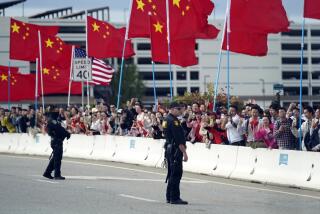With U.S. Looking Other Way, Asia Goes Its Own Way : Bloc: Malaysia suggests forming an economic system without America, paving the way for Japan to dominate the Pacific region.
TOKYO â During the past year, U.S. attention has principally focused on the economic integration of Western Europe, the collapse of the Soviet empire and now the Persian Gulf War. However deserving, these preoccupations may also be contributing to a critical loss of U.S. influence in the Asia-Pacific theater, a region whose long-term potential for the United States outweighs that of both the Middle East and Europe.
Perhaps the most chilling sign of this possible loss was a recent proposal by Malaysian officials for a new Pacific economic bloc that would exclude the United States, Canada and Australia. The suggestion, if realized, would effectively hand over the worldâs fastest-growing and most populous region to Japanese domination.
The planâs architect, Lim Kang Yaik, Malaysiaâs minister of primary industries, envisions his new Pacific bloc--most of East Asia--as an alternative to the European Economic Community and the proposed U.S.-Canada-Mexico free-trade zone. With North America and Australia on the economic sidelines, such a bloc would clearly be dominated by Japan, whose economy is almost twice as large as the rest of the Asia-Pacific region combined. Japanese officials have so far politely rejected the idea.
Still, the notion of Japan as the focal point and natural âleaderâ of Asia is prominent in the writings of such modern-day nationalists as Shintaro Ishihara, author of âA Japan That Can Say No.â It also enjoys strong support among industrialists with close ties to Asian countries.
This role, rarely talked about in polite public discourse, becomes more menacing when Japanâs increasing dominance of both investment and trade flows within the Asia-Pacific region is considered. During the past few years, Japanâs export trade with the other capitalist Asian nations has overtaken that with Europe. From affluent Taipei to impoverished rural Thailand, Japanese-made appliances, computers and, increasingly, automobiles dominate the marketplace--often without serious challenge from U.S. or European companies.
Japanâs rush into the Asian markets will likely accelerate. Japanese investments in the region are three times greater than those of the United States, and increasing at a far faster rate. In rapidly growing, oil-rich Indonesia, Japanese direct investment outpaces that of the United States and Europe combined.
By contrast, U.S. and European business investors, particularly since the collapse of Eastern Europe and the approach of West Europeâs economic integration in 1992, are hapless. During the first half of 1990, for example, Europe consumed almost half of all U.S. manufacturing investments, two times the number in Asia.
The feeling of abandonment among Asians is particularly marked in Hong Kong--the Japanese now account for more new manufacturing investments than the Americans, long the colonyâs leading supplier of industrial capital. âIt seems that Europe and America are abandoning us to save Eastern Europe and get ready for 1992,â lamented one top Hong Kong trade official. âYou are leaving us to the Japanese.â
Tragically, the Japanese Asian strategy may well reflect economic reality far more than the current U.S. enthusiasm for Europeâs long-term prospects. Despite a brief uptick in 1989 and 1990, European growth rates, including Germanyâs, during the â80s have been less than half that of the Asian nations.
Nor is there any reason to expect the Asian trend to diminish in the next decade. The economies of Eastern Europe and the Soviet Union, once seen as the bright new markets of the future, are now on the verge of collapse, with heavy debt loads and horrific infrastructural, ethnic and environmental problems. Even Germanyâs short-term future now seems less imposing, as problems with the absorption of the former East Germany continue to mount. Perhaps even more important, the continentâs aging demographics point to a gradual decline both in Western Europeâs consumer base and work force.
Asiaâs future as the focal point of the 21st Century world economy rests upon something more than hype. With a population that accounts for roughly half of humanity, its overseas trade already exceeds that of Europe and is growing far more rapidly. At the same time, both its work force and consumer base are expanding at an impressive rate, particularly in such countries as Malaysia, Thailand, Taiwan, Indonesia and Korea.
The emerging Asian countries are also beginning to outpace Europe in many critical technological industries. Taiwan, for instance, already produces more personal computers than any European state. Together, the newly industrializing Asian countries account for a full quarter of world PC production. These countries will also invest more this year in semiconductor plants and equipment than the Europeans, while production should soon start outpacing the old continent.
For U.S. business and political leaders, surrendering the lucrative Asia-Pacific markets virtually uncontested to Japan represents a geopolitical challenge at least on a par with handing over control of half the worldâs oil supply to Saddam Hussein. And unlike many in the Arab world, a sizable portion of Asiaâs leaders--particularly the largely U.S.-educated elites of Taiwan, Korea and Thailand--would welcome a more aggressive U.S. posture in the region.
Resentment toward Japan is exacerbated by its seeming unwillingness to share its massive and highly affluent home market with the emerging Asian nations. In 1989, for example, Japanâs exports to Hong Kong were more than four times greater than its imports, even though the colonyâs apparel, toys and electronics often offer far better values. Even Taiwan, whose computers and other electronics cover the world, finds it can sell barely half as much from Japan as it buys.
In sharp contrast, the United States, Canada and Australia--the Pacific partners frozen out of the Malaysian plan--have provided the ascendant Asian nations not only their largest markets, but also sources of critical technology, raw materials and, increasingly, havens for excess capital. A protectionist Pacific Trade Zone without these nations, many Asian executives fear, would leave them outgunned in a one-sided competition with the Japanese in relatively small local markets.
If the corporate, media and political elites largely obsessed with the problems of Europe and the Middle East are not soon awakened from their geopolitical slumbers, we may find ourselves winning a war while handing Japan hegemony the peace.
More to Read
Sign up for Essential California
The most important California stories and recommendations in your inbox every morning.
You may occasionally receive promotional content from the Los Angeles Times.










